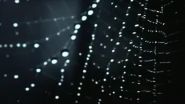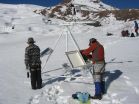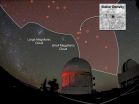At first, hidden memories that can't be consciously accessed may protect the individual from the emotional pain of recalling the event. But eventually those suppressed memories can cause debilitating psychological problems, such as anxiety, depression, post-traumatic stress disorder or dissociative disorders.
A process known as state-dependent learning is believed to contribute to the formation of memories that are inaccessible to normal consciousness. Thus, memories formed in a particular mood, arousal or drug-induced state can best be retrieved when the brain is back in that state.
In a new study with mice, Northwestern Medicine scientists have discovered for the first time the mechanism by which state-dependent learning renders stressful fear-related memories consciously inaccessible.
"The findings show there are multiple pathways to storage of fear-inducing memories, and we identified an important one for fear-related memories," said principal investigator Dr. Jelena Radulovic, the Dunbar Professor in Bipolar Disease at Northwestern University Feinberg School of Medicine. "This could eventually lead to new treatments for patients with psychiatric disorders for whom conscious access to their traumatic memories is needed if they are to recover."
It's difficult for therapists to help these patients, Radulovic said, because the patients themselves can't remember their traumatic experiences that are the root cause of their symptoms.
The best way to access the memories in this system is to return the brain to the same state of consciousness as when the memory was encoded, the study showed.
The study will be published August 17 in Nature Neuroscience.
Changing the Brain's Radio Frequencies
Two amino acids, glutamate and GABA, are the yin and yang of the brain, directing its emotional tides and controlling whether nerve cells are excited or inhibited (calm). Under normal conditions the system is balanced. But when we are hyper-aroused and vigilant, glutamate surges. Glutamate is also the primary chemical that helps store memories in our neuronal networks in a way that they are easy to remember.
GABA, on the other hand, calms us and helps us sleep, blocking the action of the excitable glutamate. The most commonly used tranquilizing drug, benzodiazepine, activates GABA receptors in our brains.
There are two kinds of GABA receptors. One kind, synaptic GABA receptors, works in tandem with glutamate receptors to balance the excitation of the brain in response to external events such as stress.
The other population, extra-synaptic GABA receptors, are independent agents. They ignore the peppy glutamate. Instead, their job is internally focused, adjusting brain waves and mental states according to the levels of internal chemicals, such as GABA, sex hormones and micro RNAs. Extra-synaptic GABA receptors change the brain's state to make us aroused, sleepy, alert, sedated, inebriated or even psychotic. However, Northwestern scientists discovered another critical role; these receptors also help encode memories of a fear-inducing event and then store them away, hidden from consciousness.
"The brain functions in different states, much like a radio operates at AM and FM frequency bands," Radulovic said. "It's as if the brain is normally tuned to FM stations to access memories, but needs to be tuned to AM stations to access subconscious memories. If a traumatic event occurs when these extra-synaptic GABA receptors are activated, the memory of this event cannot be accessed unless these receptors are activated once again, essentially tuning the brain into the AM stations."
Retrieving Stressful Memories in Mice
In the experiment, scientists infused the hippocampus of mice with gaboxadol, a drug that stimulates extra-synaptic GABA receptors. "It's like we got them a little inebriated, just enough to change their brain state," Radulovic said.
Then the mice were put in a box and given a brief, mild electric shock. When the mice were returned to the same box the next day, they moved about freely and weren't afraid, indicating they didn't recall the earlier shock in the space. However, when scientists put the mice back on the drug and returned them to the box, they froze, fearfully anticipating another shock.
"This establishes when the mice were returned to the same brain state created by the drug, they remembered the stressful experience of the shock," Radulovic said.
The experiment showed when the extra-synaptic GABA receptors were activated with the drug, they changed the way the stressful event was encoded. In the drug-induced state, the brain used completely different molecular pathways and neuronal circuits to store the memory.
"It's an entirely different system even at the genetic and molecular level than the one that encodes normal memories," said lead study author Vladimir Jovasevic, who worked on the study when he was a postdoctoral fellow in Radulovic's lab.
This different system is regulated by a small microRNA, miR-33, and may be the brain's protective mechanism when an experience is overwhelmingly stressful.
The findings imply that in response to traumatic stress, some individuals, instead of activating the glutamate system to store memories, activate the extra-synaptic GABA system and form inaccessible traumatic memories.
Traumatic Memories Rerouted and Hidden Away
Memories are usually stored in distributed brain networks including the cortex, and can thus be readily accessed to consciously remember an event. But when the mice were in a different brain state induced by gaboxadol, the stressful event primarily activated subcortical memory regions of the brain. The drug rerouted the processing of stress-related memories within the brain circuits so that they couldn't be consciously accessed.
INFORMATION:
The study was supported by grant MH078064 from the National Institute of Mental Health, grants NS061963 and NS087479 from the National Institute of Neurological Disorders and Stroke, all of the National Institutes of Health and by a Ken and Ruth Davee Award for Innovative Investigations in Mood Disorders.
NORTHWESTERN NEWS: http://www.northwestern.edu/newscenter/




